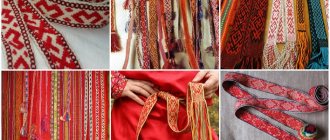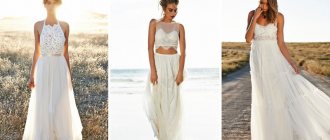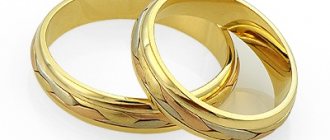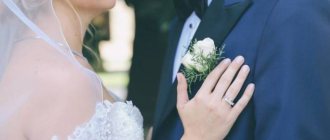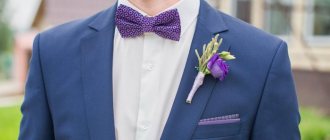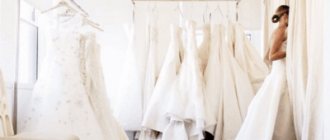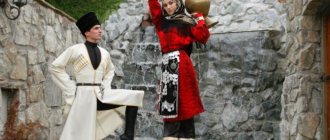The bride in Rus' sewed her own wedding dress. And it could be any color except white.
Over time, the fashion for the color of a wedding dress has changed a lot. But even today, some brides pay tribute to Slavic traditions and wear a non-white dress to their wedding.
Faktrum will tell the reader why the brides of our ancestors walked down the aisle in bright outfits.
Wreaths and ribbons
For example, the bride's headdress apparently originated from a simple wreath of flowers that was used to decorate the newlywed's head in ancient times. A peculiar interpretation was wide ribbons that were tied on the head or hoops decorated with flowers.
Kokoshnik, late 18th century. (Wikimedia Commons)
A little later, kokoshniks began to appear, embroidered with beads and ribbons, and this headdress was intended exclusively for a married woman. The bride could let her hair down, and after marriage she would braid it in two braids. Special decorations in the form of ribbons with beads and fringed braids were called “kosniks”. Sometimes the bride wore an embroidered veil under her headdress, which later turned into the familiar veil. Often long colored ribbons were attached to the back of the hoop or headband and fluttered in the wind. This headband was called a “volushka”, and after the wedding the bride gave it to her younger sisters or bridesmaids as a symbol of girlhood.
Fashion trends
The fashion of traditional Russian outfits sits tightly in every Russian soul. And let not every girl be ready to try on an absolute copy of an ancient Russian dress for her wedding. But the introduction of a minimal touch of charm in the form of embroidery in ancient motifs or the use of fur can increasingly be found at wedding celebrations.
Shoes
The most characteristic shoes to go with a traditional wedding dress should be relatively modest. Ballet flats would also look good with this outfit. Red sleepers are also quite appropriate with the flavor of modernity and Russian traditions.
Accessories and flowers
Any wedding dress, whether modern with Slavic variations or traditional Russian, should be combined as much as possible with the entire festive look.
Flowers are generally considered an ideal decor, able to fit into absolutely any image. With their help, you can emphasize such properties as tenderness and the most natural girlish modesty.
Hairstyle
Hairstyle at a wedding celebration probably means no less than the perfect wedding dress. If you follow the tradition of Russian weddings, then there are quite a few options. Although the classic Russian braid in a kokoshnik is a unique attribute, not every bride will be able to accept this option.
A bride with a hairstyle made of collected hair with woven flowers will be especially stylish and practical. Another noticeable trend among potential brides is growing their hair. Long before the wedding, they begin to intensively conjure them, care for them and protect them with redoubled force. Indeed, such romance as long curls flowing over the shoulders can charm not only the groom, but also every man at a happy wedding ceremony.
Makeup
Any wedding is, first of all, beauty and the embodiment of the naturalness of the bride. It is the bride who becomes the main character. You shouldn’t neglect your makeup, just as you shouldn’t be overzealous. Slightly drawn eyebrows, a light blush, slightly elongated eyelashes will help you create the right look. The main thing to remember here is that the best beauty is naturalness.
Three dresses for Cinderella
Usually the bride had several outfits. One was supposed to be worn at a bachelorette party, the other before marriage, and the third after. Sometimes the dress that the girl wore before the wedding was made black. It symbolized the death of the bride for the old family and old life. After the wedding, the newly-made wife was dressed in a bright sundress, signifying the joy with which the girl entered a new life. The best attire was reserved for the second day of the wedding, with dark, rich shades often chosen. The embroidery on the sundress served as a talisman, so the patterns were carefully selected.
The wedding dress was traditionally red. (culture.ru)
Who is it suitable for?
There is no traditional concept of who wedding dresses are suitable for. A wedding dress is a mandatory wedding attribute. This is a life changing event. She will forever remain both in memory and in photos and videos. Naturally, any bride will want to look irresistible on this day.
The styles of wedding dresses are very diverse. Each has its own advantages and decorative options. Don't think of a wedding dress as one of a kind. You can diversify any dress into a Russian version quite simply and effortlessly. Take, for example, the year that recently entered the modern style. It is worth adding a traditional Russian cape to it and any bride will find unique elegance in it.
Or combine such options as traditional French Provence framed with Slavic lace. No bride will go unnoticed in this image of elegance and romance.
Traditional Russian sundress. In the past, every girl was a standard of beauty and modesty. Modern fashion has not left our girls deprived of attention. The image of a wedding dress conceals both the simplicity and charm of the Russian soul. Russian sundresses especially suit plumper girls and women.
Why does a bride need long sleeves?
Under the sundress they wore a shirt, the sleeves of which were rarely embroidered. The shape of the sleeves could be different - narrow, fluffy, long (sometimes up to two meters) with slits for the arms. This unusual form appeared for a reason: it was considered a bad omen when the bride and groom touched each other’s hands during the wedding. Over the sundress, the bride could wear a soul warmer. Several petticoats were worn under the outfit - they gave the pomp that was so valued in a woman. Girls from boyar and princely families wore a long cloak of brocade with gold embroidery over their sundress. The dresses of rich brides were often embroidered with pearls and trimmed with fur. Some wedding dresses weighed up to 15 kilograms.
Style
As simple and comfortable as possible. Wide skirts, long sundresses, simple shirts. For tailoring, exclusively natural materials were used: linen, cotton, chintz, wool.
Costume elements
The collar was most often turned-down and had a round shape. The sleeves were narrow long or short lanterns. Women's or men's suits were often complemented with belts and laces.
Color spectrum
Among the most used colors in Russian costume were yellow, red, white, black, green and blue paint. Golden shades were very common, especially in decoration, decor or accessories.
Ornaments
Floral patterns, birds, animals, ancient Russian patterns are the most popular and most frequently used examples of clothing decoration. Ornamental figures were embroidered with gold and silver threads, decorated with bright ribbons, beads, multi-colored stones, lacing, lace or braid.
Patchwork clothing
Patchwork clothing is a separate part of the culture of the ancient Slavs. Today, the art of creating clothing or household items from colorful scraps of fabric is called patchwork. Blankets, pillowcases, and rugs were previously sewn using this technique. Today this style is actively used to create skirts, dresses, and outerwear. And Pavloposad shawls are often used as bright, colorful shreds.
Accessories
Bright beads, lush wreaths of wildflowers, ribbons woven into long braids, large colored beads, tall kokoshniks, colorful shawls and painted scarves are just an incomplete list of decorations and additions to Russian costume.
Modern designers see the “Russian style” in their own way and create their collections based on this vision. For example, Yves Saint Laurent was one of the first to appreciate clothing in the Russian style and presented collections of outerwear stylized as ancient sheepskin coats on the Parisian catwalks. Of course, the designer's models had a more sophisticated and stylish style than the original models. Shortened sheepskin coats were decorated with sable or marten fur trim and beautiful, rich embroidery.
Among other famous masters whose collections included clothes in the Russian style, one can note Valentino, Dolce&Gabbana, Jean Paul Gaultier, Vyacheslav Zaitsev, Valentin Yudashkin.
Prepare your sleigh in the summer, and prepare your dress from childhood
In some regions there was a tradition according to which the bride had to embroider her own outfit. So the girl could work on her future wedding dress from childhood. Thanks to this, all the guests at the wedding could see what a craftswoman the girl was. Over time, this tradition became obsolete, and the sundress was embroidered by the whole family. Often the outfit was passed down by inheritance, especially in poor families. Sometimes such dresses were entire works of art: made of red silk or brocade, embroidered with gold and beads, decorated with ribbons - they could be put on display in a museum right now.
Festive costume of the bride of Kostroma. (wysotsky.com)
Early in the morning before the wedding, the groom handed over the “groom’s box” to the bride’s house. It contained rings, a veil, and wedding candles. The groom also prepared shoes for the bride. This was also symbolic: the girl left her parents’ house to go to her groom in order to continue going through life with him. The shoes were put on the feet by the “wedding boy” - often the bride’s younger brother. And the girl was dressed by her mother or some kind of stylists - “outfitters”.
Red is so symbolic
I advise you to pay attention to the red models, which will be very symbolic, given that until the end of the 19th century this was the obligatory color of wedding attire, closely associated with such a common saying of that time as “The maiden is beautiful.”
Groom's outfit
With the groom's suit, things were somewhat simpler. During matchmaking, the girl gave her betrothed a silk or calico embroidered scarf, which he had to wear around his neck and in his pocket until the wedding. The outfit itself consisted of blue pants with small stripes, often made of cloth, and a red shirt, embroidered on the sleeves and hem. It was the bride's job to embroider the groom's shirt. Then the groom girded himself with a woven belt and sometimes put on a caftan or fur coat.
Men's wedding suit, early 20th century. (colors.life)
A wedding in Rus' was not much like a modern one. The white dress of the bride began to appear at weddings only under Peter, and only took root at the beginning of the 20th century. During the Soviet era, in the era of total economy, it was considered a disgrace to spend huge pieces of fabric and expensive jewelry on a dress that a girl would wear once in her life.
Russian folk wedding costume
The solemn and long-awaited wedding day should always be held in the style that the newlyweds choose. There are a lot of themes for weddings, but folk style deserves special attention. The holiday will combine not only specific clothing, but also the traditions of ancestors. The Russian folk wedding costume should have a special place, and it will have to be chosen with the utmost care, it is advisable to even remember historical facts. And grandparents can suggest traditions that have long been forgotten by everyone.
